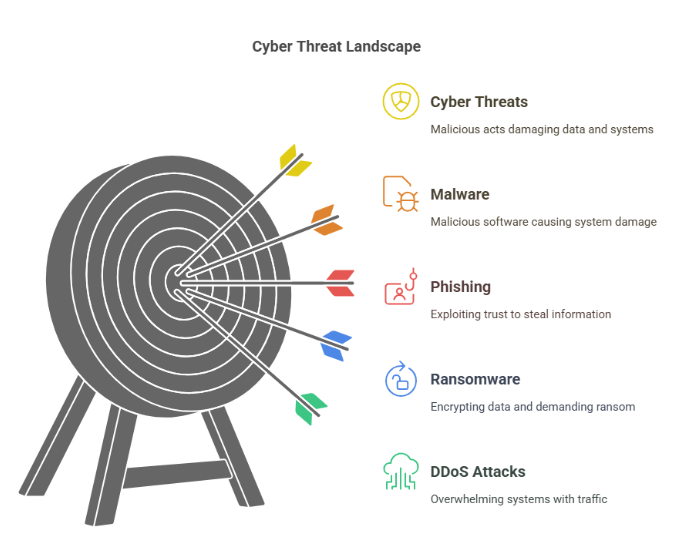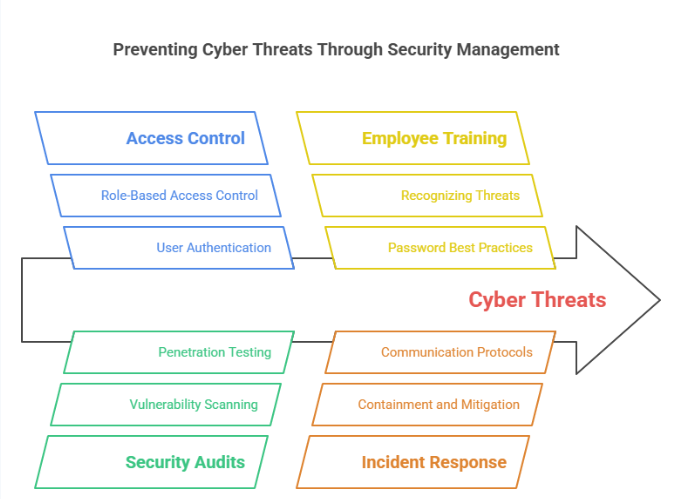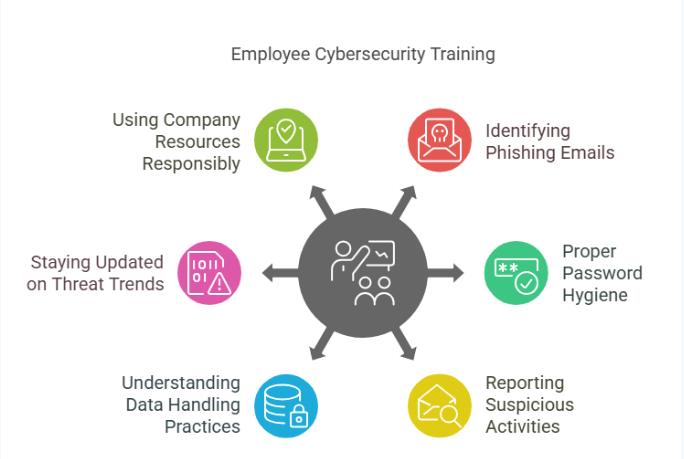In an increasingly connected world, businesses are becoming prime targets for cybercriminals. Cyber threats have grown in complexity and scale, from simple phishing attacks to sophisticated ransomware campaigns. As businesses move more of their operations online, protecting sensitive data and digital infrastructure has never been more critical. This is where security management plays a pivotal role.
A comprehensive security management system helps businesses identify, assess, and mitigate cyber threats before they cause significant harm. In this blog, we will explore how security management can help prevent cyber threats, the key strategies involved, and the role of cybersecurity in modern security management systems.
To dive deeper into security management, visit our blog on what is security management.
Understanding Cyber Threats
In today’s digital landscape, where almost every business operation relies on technology, understanding cyber threats is more critical than ever. From multinational corporations to small businesses, no organization is immune. Before we explore how security management helps in preventing these threats, it’s important to gain a comprehensive understanding of what cyber threats are, the different forms they take, and the damage they can cause.
Cyber threats are malicious acts that seek to damage data, steal information, or disrupt digital life in general. These threats can originate from a variety of sources, including individual hackers, criminal organizations, or even nation-states. They may target personal computers, large corporate networks, or critical infrastructure. While the types of cyber threats continue to evolve with technology, several major categories remain consistent.

Malware
Malware, short for “malicious software,” is one of the most well-known and widely encountered types of cyber threats. It refers to any software designed to cause damage to a computer system, steal data, or carry out other malicious tasks without the user’s consent. There are several kinds of malware, including:
-
Viruses: Attach themselves to clean files and spread to other files and systems.
-
Worms: Replicate themselves and spread across networks without needing a host file.
-
Trojans: Disguise themselves as legitimate software but carry malicious instructions.
-
Spyware: Secretly records user activity and sends the data to attackers.
-
Ransomware: Encrypts files or entire systems and demands payment for access.
Malware infections can lead to severe consequences, such as the loss of sensitive customer data, operational disruptions, and reputational damage. In worst-case scenarios, they can cause businesses to shut down entirely.
Phishing
Phishing is a form of cyber attack that exploits human psychology rather than technological vulnerabilities. Attackers pose as trustworthy entities, such as a bank or a known service provider, and trick users into revealing confidential information. This can happen through:
-
Emails with fake links or attachments.
-
SMS messages asking for urgent verification.
-
Fake websites that mimic legitimate ones.
Once the victim provides their credentials or personal information, attackers can access accounts, steal identities, or commit fraud. Phishing attacks are highly effective because they rely on trust and urgency, and they are a leading cause of data breaches.
Ransomware
Ransomware deserves its own spotlight due to its destructive nature and increasing frequency. This type of malware encrypts files on a computer or network, locking out the user. The attacker then demands a ransom, typically in cryptocurrency, in exchange for the decryption key. Some common variants of ransomware include WannaCry, Ryuk, and LockBit.
The impact of ransomware attacks can be devastating. Hospitals, schools, government agencies, and private companies have all fallen victim, sometimes paying millions of dollars to regain access to their data. Even if the ransom is paid, there’s no guarantee the attacker will provide the key—or that the data hasn’t already been stolen.
DDoS Attacks
Distributed Denial-of-Service (DDoS) attacks aim to make a machine, network, or service unavailable to its intended users. This is done by flooding it with excessive traffic from multiple sources, often using a botnet— a network of infected devices controlled by the attacker.
The objective of a DDoS attack isn’t necessarily to steal data but to disrupt operations. E-commerce websites, online gaming services, financial institutions, and government portals are common targets. These attacks can cause massive downtime, lost revenue, and damaged customer trust.
Insider Threats
Not all cyber threats originate from outside the organization. Insider threats occur when someone within an organization—such as an employee, contractor, or business partner—misuses their access to systems and data. This misuse can be intentional, like stealing intellectual property for personal gain, or unintentional, such as clicking on a malicious link that introduces malware into the system.
Insider threats are particularly dangerous because these individuals often have legitimate access to sensitive information. Traditional security measures may not detect their activities, making these threats harder to identify and prevent. Building a culture of security awareness, coupled with access controls and monitoring tools, is essential to address this type of threat.
The Role of Security Management in Preventing Cyber Threats
In today's digital world, organizations are constantly under threat from cyberattacks. These attacks can come in many forms—ransomware, phishing, malware, data breaches, and insider threats, to name a few. Now that we’ve defined some of the most common cyber threats, it’s crucial to explore how security management plays a central role in preventing them. Security management provides a structured, strategic approach to safeguarding an organization’s IT infrastructure, data, and assets from both internal and external cyber risks.
Let’s break down the critical components of effective security management and how each contributes to protecting against cyber threats.

Implementing Strong Access Control
One of the foundational elements of cybersecurity is controlling who can access what within an organization’s network. Effective access control ensures that only authorized individuals can view or modify sensitive data and systems. By limiting access, organizations reduce the risk of data leaks, unauthorized changes, or internal misuse.
User Authentication: Security management systems use robust authentication methods to verify user identities before granting access. One widely adopted method is multi-factor authentication (MFA), which requires users to present two or more forms of verification. For example, a user might need to enter a password (something they know), provide a fingerprint scan (something they are), or use a one-time code sent to their phone (something they have).
MFA significantly increases security because it becomes much harder for an attacker to gain access using stolen credentials alone.
Role-Based Access Control (RBAC): Another key strategy is Role-Based Access Control (RBAC). With RBAC, employees are granted access permissions based on their job responsibilities. This principle of “least privilege” ensures users can only access the information they need to perform their duties—nothing more, nothing less.
For example, an HR manager might have access to employee records but not to the company's financial databases. This kind of control helps prevent both accidental and malicious data breaches.
Regular Security Audits and Vulnerability Assessments
Cyber threats evolve quickly, and even the most secure systems can develop vulnerabilities over time. That’s why regular security audits and vulnerability assessments are essential components of any security management plan.
Vulnerability Scanning: Automated vulnerability scanning tools help organizations continuously monitor their systems for weaknesses. These tools check for outdated software, misconfigurations, default passwords, and unpatched security holes. When identified, these issues can be resolved quickly before they are exploited by malicious actors.
Regular scanning not only keeps systems secure but also ensures compliance with industry regulations and cybersecurity standards.
Penetration Testing: Unlike vulnerability scanning, penetration testing involves simulating real-world cyberattacks to test the resilience of an organization’s defenses. These controlled attacks, performed by cybersecurity professionals, reveal how well current security measures hold up against advanced threats.
By conducting penetration tests, businesses can uncover hidden weaknesses and better understand how a real attacker might attempt to infiltrate their systems. This proactive approach helps organizations prioritize security improvements based on real-world risk scenarios.
Ongoing Security Training and Awareness
Technology alone cannot prevent cyber threats—human behavior plays a major role in cybersecurity. That’s why employee education is a vital part of security management.
Many cyberattacks, such as phishing emails or social engineering tactics, rely on manipulating users into giving away sensitive information. If employees are unaware of these tactics, they can unintentionally open the door to a cyberattack.
Regular cybersecurity training helps employees:
-
Recognize and report suspicious emails or messages.
-
Understand password best practices.
-
Avoid risky online behavior.
-
Stay informed about the latest threats.
By fostering a culture of security awareness, organizations empower their employees to act as the first line of defense against cyber threats.
Establishing Incident Response Plans
Even with strong defenses, no system is completely immune to attacks. That’s why having a well-defined incident response plan (IRP) is crucial. Security management includes the creation and maintenance of response protocols that kick into action if a breach or attack occurs.
An effective IRP outlines:
-
Steps to contain and mitigate the attack.
-
Roles and responsibilities of team members during an incident.
-
Procedures for communicating with stakeholders.
-
Guidelines for restoring normal operations.
-
Requirements for documenting and analyzing the incident to prevent future occurrences.
By preparing in advance, organizations can respond quickly and effectively to minimize damage and recover faster.
Continuous Monitoring and Real-Time Alerts
Cyber threats can happen at any time. Continuous monitoring tools are essential for real-time detection and response. These tools track network activity, flag unusual behavior, and generate alerts when potential threats arise.
For instance, if an employee’s account suddenly starts downloading large volumes of data at odd hours, monitoring systems can detect this abnormal activity and trigger an alert. Security teams can then investigate and take immediate action if necessary.
Real-time monitoring ensures that threats are identified early—often before they cause significant harm.
Data Encryption and Backup
In the event of a cyberattack, data encryption ensures that even if malicious actors gain access to the system, they cannot read or use sensitive data.
-
Encryption: Encrypting sensitive data in transit (e.g., emails) and at rest (e.g., databases) ensures that it remains secure, even if intercepted.
-
Data Backup: Regular data backups help organizations recover quickly in the event of a ransomware attack or data breach.
Having a robust data protection plan is crucial in minimizing the impact of cyber threats.
Employee Training and Awareness
One of the most significant threats to any organization’s cybersecurity is human error. Even the most advanced security systems can be rendered ineffective if employees are not properly trained and aware of the potential risks. Many data breaches and cyber incidents occur because employees inadvertently expose sensitive information—whether by falling for phishing scams, using weak passwords, or failing to follow basic security protocols.
To address this issue, security management must prioritize ongoing employee training and awareness programs. These initiatives are not just one-time sessions, but continuous efforts designed to keep employees updated on evolving threats and the best practices for dealing with them.

Key Areas of Employee Training:
-
Identifying Phishing Emails:
Phishing is one of the most common and dangerous cyber threats. Employees should be trained to recognize the warning signs of phishing emails, such as suspicious sender addresses, poor grammar, urgent requests, or unfamiliar links. Regular simulations and tests can be conducted to help employees practice identifying these threats in a safe environment. -
Proper Password Hygiene:
Weak or reused passwords are easy targets for hackers. Training should cover the importance of creating strong, unique passwords and using multi-factor authentication (MFA) wherever possible. Employees should also be encouraged to use password managers to store credentials securely instead of writing them down or using the same password across multiple platforms. -
Reporting Suspicious Activities:
Employees are often the first line of defense when something unusual happens. They should know how and when to report suspicious emails, unauthorized system access, or other unusual behavior. Establishing a clear, non-punitive process for reporting helps create a culture where vigilance is encouraged and supported. -
Understanding Data Handling Practices:
Training should also include proper data handling procedures. This involves understanding how to store, transfer, and dispose of sensitive information securely. Employees need to be aware of data classification levels and how to treat different types of information accordingly. -
Staying Updated on Threat Trends:
Cyber threats evolve rapidly. By offering regular updates and refresher courses, organizations can ensure their employees are aware of the latest tactics used by cybercriminals. Incorporating real-world examples into training can make sessions more engaging and relatable. -
Using Company Resources Responsibly:
Employees should be educated on the importance of using company devices and networks for work-related purposes only. Accessing untrusted websites or downloading unauthorized software can introduce malware and compromise security.
Conclusion
In today’s digital landscape, cyber threats are an ever-present danger that can significantly impact an organization’s reputation and financial health. However, with a comprehensive security management system in place, businesses can proactively defend against these threats. From strong access control to advanced threat detection, security management provides the tools and processes necessary to protect sensitive data and ensure business continuity.
At ACSMI, we understand the importance of safeguarding your digital assets and maintaining compliance with industry regulations. We offer medical coding and billing certifications to help professionals understand how to protect sensitive patient data and comply with legal requirements. We also provide a wide range of snacks online, perfect for keeping your team fueled while managing cybersecurity risks.
FAQs
What types of cyber threats can security management prevent?
Security management can help prevent malware, phishing, ransomware, DDoS attacks, and insider threats by using a combination of prevention strategies like encryption, access control, and threat detection.
How does access control prevent cyber threats?
Access control systems limit access to sensitive data, ensuring only authorized personnel can access critical systems, preventing unauthorized actions that could lead to data breaches.
What is the importance of employee training in preventing cyber threats?
Ongoing employee training helps individuals recognize potential cyber threats, such as phishing emails, and ensures they follow best practices for cybersecurity, reducing the risk of human error.
How do threat detection systems work in preventing cyberattacks?
Threat detection systems monitor network traffic for unusual patterns, helping detect potential breaches early so that security teams can respond swiftly to mitigate damage.
What role does data encryption play in protecting against cyber threats?
Data encryption ensures that even if a cybercriminal gains access to data, they cannot read or use it without the decryption key, safeguarding sensitive information.

Leave a Reply